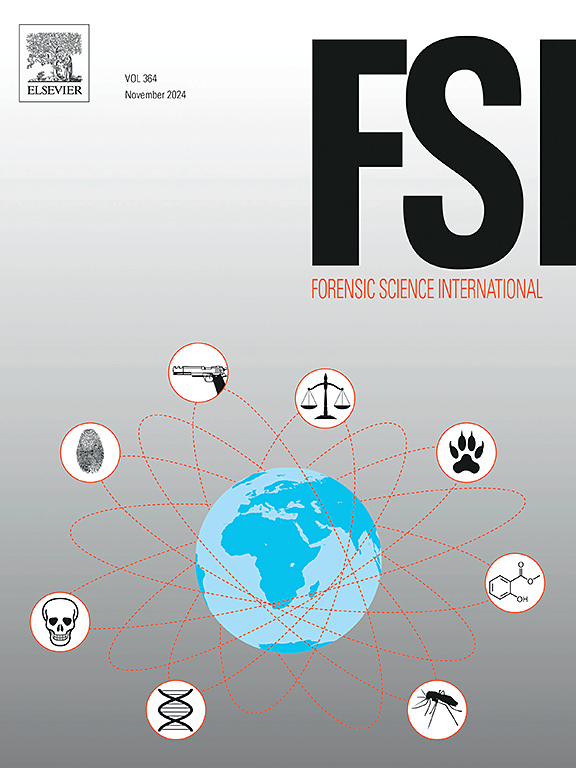在法医真空金属沉积室中使用非热等离子体进行 DNA 净化:概念验证研究
IF 2.5
3区 医学
Q1 MEDICINE, LEGAL
引用次数: 0
摘要
真空金属沉积(VMD)通常用于各种类型证据的手印开发。为了最大限度地提高证据价值,在采集DNA之前先处理指纹,在努力实施顺序法医工作流程时,必须防止被分析物品之间的交叉污染。非热等离子体(NTP)在DNA去污方面具有潜在的优势,因为它可以到达传统UV-C光无法到达的区域,并且消除了可能干扰真空系统的溶剂的需要。在这项研究中,在VMD室中产生的不同NTP条件对已知DNA浓度的人类细胞和无细胞DNA进行了测试。这包括功率(最大和中等),曝光时间(0.5 h, 1 h, 2 h)和压力(1.68,2,4.27 ×10−1毫巴)的变化。总的来说,血浆治疗后观察到DNA浓度降低了约100倍。在测试条件中,1 h, 2 × 10−1 mbar和最大功率被证明是最稳定的DNA去除等离子体。虽然UV-C光通过将DNA水平降低到检测极限以下并显示显着降解,在直接视线内降解无细胞DNA更有效,但NTP在消除视线外的DNA方面更有效。这些发现表明,NTP可能是一种很有前途的工具,用于像VMD这样的法医仪器的DNA净化。未来的研究应侧重于优化NTP设置,包括功率输出和真空条件,以确保完全去除DNA。本文章由计算机程序翻译,如有差异,请以英文原文为准。
The use of non-thermal plasma for DNA decontamination in a forensic vacuum metal deposition chamber: A proof of concept study
Vacuum Metal Deposition (VMD) is routinely deployed for fingermark development on various types of evidence. In efforts to implement a sequential forensic workflow where fingermarks are processed before DNA collection to maximise evidential value, it is essential to prevent cross-contamination between analysed items. Non-thermal plasma (NTP) presents a potential advantage in DNA decontamination as it can reach areas that are inaccessible to conventional UV-C light and eliminates the need for solvents that might interfere with the vacuum-based systems. In this study, different NTP conditions generated within a VMD chamber were tested on human cells with known DNA concentrations, and cell-free DNA. This included variations in power (maximum and medium), exposure times (0.5 h, 1 h, 2 h), and pressures (1.68, 2, 4.27 ×10−1 mbar). Overall, a reduction of approximately 100-fold in DNA concentration was observed after plasma treatment. Out of the tested conditions 1 h, 2 × 10−1 mbar and maximum power proved to be the most stable plasma for the DNA removal. While UV-C light was more efficient at degrading cell-free DNA in direct line of sight by reducing DNA levels below the limit of detection and showing significant degradation, NTP was more effective at eliminating DNA out of the line of sight. These findings suggest that NTP could be a promising tool for DNA decontamination of forensic instruments like VMD. Future research should focus on optimizing NTP settings, including power output and vacuum conditions, to ensure complete DNA removal.
求助全文
通过发布文献求助,成功后即可免费获取论文全文。
去求助
来源期刊

Forensic science international
医学-医学:法
CiteScore
5.00
自引率
9.10%
发文量
285
审稿时长
49 days
期刊介绍:
Forensic Science International is the flagship journal in the prestigious Forensic Science International family, publishing the most innovative, cutting-edge, and influential contributions across the forensic sciences. Fields include: forensic pathology and histochemistry, chemistry, biochemistry and toxicology, biology, serology, odontology, psychiatry, anthropology, digital forensics, the physical sciences, firearms, and document examination, as well as investigations of value to public health in its broadest sense, and the important marginal area where science and medicine interact with the law.
The journal publishes:
Case Reports
Commentaries
Letters to the Editor
Original Research Papers (Regular Papers)
Rapid Communications
Review Articles
Technical Notes.
 求助内容:
求助内容: 应助结果提醒方式:
应助结果提醒方式:


